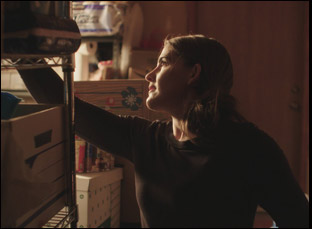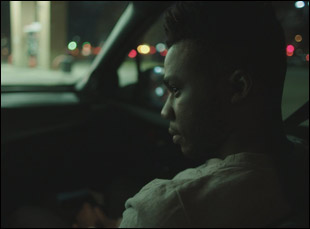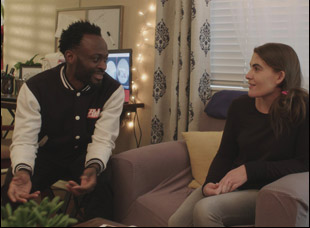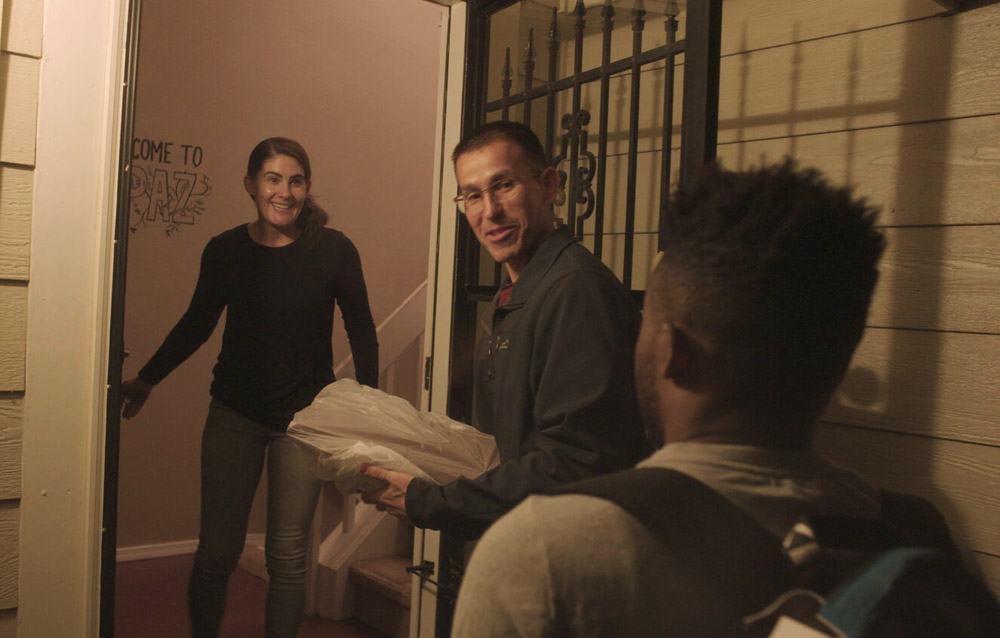One of the first things Dia Sokol Savage learned about Sarah Jackson, who runs Casa de Paz in Denver, Colorado, is that she’s not a morning person.
“The day that I met her, she was complaining [about how] she hated to wake up early, but she had an interview with the head of ICE in Colorado,” recalls Savage of the tireless subject of her new film “Welcome Strangers” who offers post-release housing and support for recently released detainees. “[They were going] to talk about the fact that they were releasing immigrants out the back of the prison, which is even more disorienting and confusing [that that experience already is] and it makes it really hard to make contact with them.”
As it happens, this is why Jackson has a better reason than most to hit the snooze alarm, as you can see from the harrowing opening scenes of “Welcome Strangers” in which she can be seen in the middle of the night, laughing to herself about the craziness inherent in the brilliant rescue operation that she first conceived in 2012. With an army of volunteers, Jackson will wait outside an ICE Detention Facility and invite those who wander out, usually knowing nothing about their surroundings after arriving in America to seek asylum, back to Casa de Paz to collect themselves and figure out their next steps forward, not needing to worry about a roof over their head.
If seeing Jackson open her arms to the most vulnerable in their time of need isn’t enough of a reason to cherish “Welcome Strangers,” the 20-minute short should be celebrated as a return to the director’s chair for Savage, who has spent the past decade as the showrunner on MTV’s “16 and Pregnant” and “Teen Mom,” which she was one of the creators of after producing films for Andrew Bujalski and making her own charming narrative debut “Sorry, Thanks,” which premiered at SXSW in 2009. Luring the “Support the Girls” director’s go-to cinematographer Matthias Grunsky to Denver for late night shoots, the filmmaker captures the ripple effect of Jackson’s generosity while staying in a single moment, spending time with Oliver, an emigre from Cameroon who went from being retrieved by Casa de Paz to helping others as Jackson’s partner in the organization, and witnessing former detainees use Casa de Paz’s resources to reconnect with loved ones.
After making its world premiere at the Big Sky Documentary Film Festival in February, “Welcome Strangers” is segueing online in wake of the coronavirus, making its international debut as part of the Hot Docs virtual festival that’s available to residents of Ontario this week, and Savage was kind enough to talk about how she was moved to make the film after a call from her mom, the challenge of approaching subjects to film at a most delicate time and how the documentary has already moved audiences to action.

It was really just feeling incredibly drawn to this idea. My mom, who lives in Denver, went to a training at Casa de Paz to be a volunteer and I spoke to her that day and I had never heard of anything like that. This was right in the aftermath of the U.S.’s zero tolerance immigration policy at the border, and I was feeling really helpless and confused. I was doing some volunteering in my own life to address some of those feelings, but as soon as I heard about what they were doing at Casa de Paz, helping immigrants right at that moment of release and transition into whatever their new lives might be in the United States, I was just really compelled by it and it felt and sounded like a film.
I went and met with Sarah Jackson and she’s just someone who is always making things happen and if you’re a documentary subject, that’s incredibly valuable. She just felt like a mover and a shaker and [we] just had a really nice rapport, so I left that first visit to the Casa saying I want to spend some more time here and try to tell this story. Obviously, it took months of prep and getting to know [the people at Casa de Paz] and earn their trust and [figuring out] strategically how not to increase the stress for people that have been released by shoving cameras in their faces, but also I really wanted to make sure the look of the film was accurately portraying the magic that happens in the Casa.
What kind of sensitivity was involved in bringing a camera into that situation where these people are leaving detainment in the dead of night and don’t know where they’re going in Denver?
It was a little bit terrifying as an endeavor because there was no sure thing. We didn’t know whether or not anyone would get released on the nights that we were filming and we didn’t know if the people who would be released would want to share their stories with us. We wanted to tread lightly and respectfully with these people and not create more fear because obviously they have good cause to be very paranoid and untrusting, which even [within] the characters who we filmed, they were concerned that the volunteers were actually from immigration and taking them back to prison, so we had a lot of logistics to figure out. Some of the way we did that was communicating and asking [questions] again and again and making sure that we had translators who could explain again and again, because people can’t always hear when they’re in a traumatized state or it can be very, very difficult to understand.
In some ways, we were mirroring the work that the volunteers do because they face very much the same things. The people come out [of detention centers], the volunteers are strangers and they are saying, “Come here, come to this house with me. We’ll help you.” And the people will go often because they have no other options. Sometimes they’ve heard about Casa de Paz, and sometimes their lawyers have told them about it and arranged it, but more often than not, it’s just blind faith. So we were mirroring that. We would watch the volunteers earn the trust of these immigrants who had just been released, and so to would they understand that we were just there telling the story and documenting it.

Not at all. Every week is both different and the same. They just always have people being released and now in light of COVID-19, it would probably be a very rich period because a number of people en masse have been released, so it isn’t as typical from the numbers they usually see, but there’s not a certain time they see heavy traffic. There are certain periods where more people get released from certain countries than from other countries and you can follow certain trends. But we just chose randomly, and we filmed in December. There were actually a lot of conversations with Matthias [Grunsky, the cinematographer] about making sure that we were going to film in the darkness and is that going to work because obviously if we’re to film now in the middle of the summer, it’s light when people are getting released, but we decided that that sort of darkness and confusion, which was accurate, maybe helps people’s ability to understand how scary it is for these people who have been released and don’t know where they are.
That’s one of those subtle elements that really gives you a sense of the experience. When you’re constrained to a single moment in time, was it a challenge giving those impressions throughout of the larger work that Casa de Paz is doing? It’s hinted at throughout the film without ever overwhelming it.
Yeah, the scope of what they do shifts and gets bigger and if we made a feature, we would’ve increased the scope to talk about immigration policy and the kinds of collaborations between other individuals and organizations who are trying to help immigrants who have just been released. But in some ways, [this story] was actually very simple. On the most basic level, what they do [at Casa de Paz] every night, just regular people making and delivering meals and offering to give someone a ride is such a paradigm shifter. It sounds so simple yet there’s so much wrapped up into it, so I always knew that was going to be the heart of the film.
I will be honest — when I was filming, I had no idea if people were going to be released or I was going to be able to film them, so I shot every minute of the days we were [there] from the crack of dawn until it was the time to go pick people up, so I filled it with all kinds of things they’re doing day to day. They’re making Christmas cards and delivering them to immigrants and they’re driving people back to ICE because they have paperwork that they need and they’re figuring out the logistics of how to get people through security at the airport, and the days at the Casa are also very busy and interesting, but ultimately I didn’t end up using any of that in the film because I felt like what was most compelling was the interactions with the people who were fresh out of having been in prison.
Was there anything that happened that you weren’t expecting?
Any good film your expectations get turned upside down, otherwise it might not be as interesting as you thought, so there were a lot of different moments. I visited Casa as part of my preproduction a number of times, and every time, there was an actual moment where you could feel the guest go from having been terrified, having had this horrible experience of being in prison and being far away from their families and having so much uncertainty, to really just feeling like they trusted the volunteers and that they were in a safe place. It was an almost tangible moment and it happened with each person and it was just the most amazing thing to witness. You just wanted to capture this moment where it’s like, “Oh, these are our friends.” It was lovely.

Right. [laughs] One of our huge challenges when we were editing is that everyone was saying, “I’m so confused. Do they know each other?” because it was such a warm thing, so we had to do all these little tricks to make it clear, “No, no, no, they didn’t.” They were just so happy to be finding each other. One thing that surprised me, and my regret, was that I didn’t get to share any stories of the women who got released. They were just more skeptical and less open. By the end of their stay at the Casa, they had all given us permission and were happy to be on camera, but I couldn’t really include their stories and that was just part of respecting their wishes when they first were out.
Although your travel plans must’ve changed in wake of the coronavirus, you were able to premiere this at Big Sky right before. What was it like?
It was so magical. We were able to go there with Sarah and Oliver and it was great as a director [because] I didn’t have to talk at all. All people wanted to do during the Q & A was ask them questions about the work that they’re doing and I’d never seen people cry harder during a Q & A than they did during the movie, so it was pretty powerful. And the screening was sponsored by a local organization that also helps immigrants, so we were able to make connections with a other groups and had people in the audiences who were themselves immigrants and while they don’t have hospitality houses there, they do have some organizations that help immigrants and refugees resettle, so it was wonderful.
I thought about it mostly in terms of Oliver, who hasn’t spent much time doing any kind of leisure travel in his life, so that was fabulous [although] it’s been sad not to be able to travel around with the film [more]. But I’m so glad we got that in and I hope to do more. I made this film as a short because I felt it would have a longer life and be welcomed into places that maybe a feature-length film about immigration wouldn’t be. We’ve had a lot of interest from church groups and community groups, and luckily for us, our distribution plan for this film was not contingent on [selling out of] a festival, but they are a wonderful means to spread the word. We just played at Telluride Mountain Film this last week and people have been writing to Sarah, donating clothes and somebody called her and said, “Hey, I want to get cell phones to these people.” Somebody [else] got their friends together and donated thousands of dollars from her own fundraising efforts, so it really is about getting the word out and I hope we can still do that in light of this current craziness.
“Welcome Strangers” will be streaming through DOC NYC as part of Shorts Program: Stand Up from November 11th through 19th.




